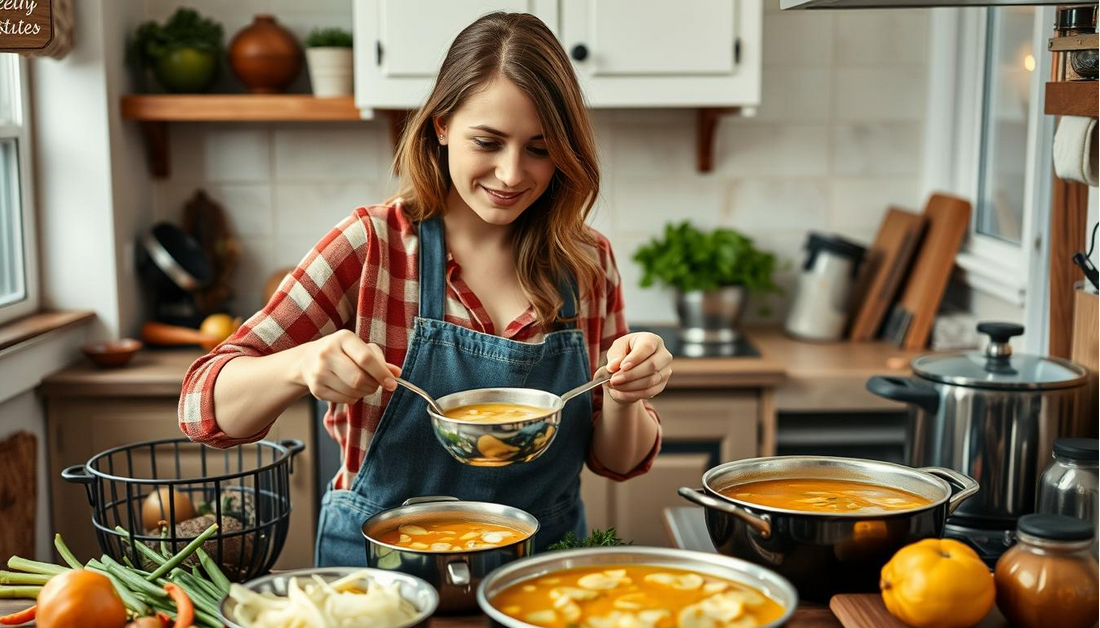India customers to view on amazon.in
The Secret Ingredient That Elevates This Onion Soup
Onion soup, a classic comfort food, has been a staple in many cuisines for centuries. Its rich flavor and aroma have the power to warm hearts and homes. But what makes a gourmet onion soup truly stand out? The answer lies in a secret ingredient that elevates this beloved dish to new heights.
- The Rich History of French Onion Soup
- Why Traditional Onion Soup Often Falls Short
- The Secret Ingredient That Elevates This Onion Soup
- The Science Behind the Magic
- Essential Base Ingredients for Perfect Onion Soup
- Mastering the Art of Caramelization
- Step-by-Step Recipe for Elevated Onion Soup
- The Perfect Cheese Topping Combination
- Wine and Alcohol Additions That Complement Star Anise
- Serving Suggestions and Pairings
- Bread Selection for the Perfect Crouton
- Side Dishes That Balance the Richness
- Wine Pairing Recommendations
- Conclusion: Transforming a Classic into Something Extraordinary
- FAQ
- What is the secret ingredient that elevates onion soup?
- How do I caramelize onions for onion soup?
- What type of onions are best for onion soup?
- Can I use a different type of cheese instead of Gruyère?
- What is the best broth to use for onion soup?
- How can I enhance the flavor of my onion soup?
- Can I make onion soup without wine?
- What are some good side dishes to serve with onion soup?
- How do I achieve a perfect cheese pull on my onion soup?
- Can I make onion soup in a slow cooker?

A flavorful onion soup is more than just a recipe; it’s an experience. By incorporating a specific ingredient, you can transform a simple onion soup recipe into an elevated onion soup that delights the senses.
Key Takeaways
- Discover the secret to making an extraordinary onion soup.
- Learn how to elevate your onion soup recipe with a simple ingredient.
- Understand the importance of using quality ingredients in your cooking.
- Explore the versatility of onion soup in different cuisines.
- Get tips on creating a flavorful and gourmet onion soup.
The Rich History of French Onion Soup
The history of French onion soup is as rich and layered as the soup itself, with roots tracing back to 18th century France. This classic dish has not only stood the test of time but has also become a staple in cuisines around the world.
Origins in 18th Century France
French onion soup originated as a peasant food in 18th century France, made with simple ingredients like onions, bread, and broth. The traditional French onion soup recipe was born out of necessity, using readily available ingredients to create a nourishing meal. Over time, it gained popularity among the upper classes, who refined the recipe and added their own twist.
The original French onion soup was quite different from the version we know today. It was more rustic and less sophisticated, but its flavor profile was already captivating. As French cuisine evolved, so did the soup, incorporating new techniques and ingredients.
Evolution into a Global Comfort Food
As French cuisine spread globally, comfort food onion soup became a favorite in many cultures. The dish adapted to local tastes, with variations emerging in different parts of the world. Despite these changes, the core essence of French onion soup remained intact, retaining its status as a traditional french onion soup beloved by many.
Today, French onion soup is enjoyed not just in France but worldwide, often served at gatherings and in restaurants. Its evolution into a global comfort food is a testament to its enduring appeal and the versatility of the french onion soup recipe.

Why Traditional Onion Soup Often Falls Short
Onion soup, a dish revered for its simplicity and flavor, is often marred by common culinary mistakes. Despite its straightforward ingredients, the preparation of onion soup can be nuanced, and errors can lead to a less satisfying result.
Common Mistakes in Preparation
One of the most common mistakes in onion soup preparation is the inadequate caramelization of onions. Onions that are not cooked slowly enough or at the right temperature can lack the deep, sweet flavor that is characteristic of a good onion soup. Another mistake is using low-quality broth or stock, which can result in a soup that tastes bland or unappetizing.
To avoid these pitfalls, it’s essential to slow-cook the onions until they’re dark and caramelized, and to use a high-quality broth as the base of the soup. Additionally, not using the right type of onions can affect the flavor; for instance, using sweet onions like Vidalia can add a different dimension compared to yellow or white onions.
| Common Mistake | Impact on Flavor | Correction |
|---|---|---|
| Insufficient caramelization of onions | Lack of deep, sweet flavor | Slow-cook onions until dark and caramelized |
| Using low-quality broth | Bland or unappetizing taste | Use high-quality broth or stock |
| Incorrect type of onions | Altered flavor profile | Choose appropriate onions for the desired flavor |
The Missing Depth of Flavor
The depth of flavor onion soup is often lacking due to the omission of key ingredients or the use of inadequate cooking techniques. Adding a secret ingredient like star anise can significantly enhance onion soup by introducing a complex, aromatic flavor that complements the onions.
To improve onion soup, consider incorporating other aromatics such as garlic, bay leaves, or thyme. These ingredients can add layers to the soup, making it more engaging and satisfying. Experimenting with different combinations can help achieve the desired depth of flavor.

The Secret Ingredient That Elevates This Onion Soup
When it comes to elevating a classic onion soup, one secret ingredient stands out among the rest: star anise. This spice, known for its distinctive flavor and aroma, has the power to transform a simple soup into a culinary masterpiece.
Star anise, with its sweet and licorice-like flavor, adds a depth to onion soup that is hard to achieve with other ingredients. It’s a game-changer for those looking to elevate their onion soup recipe and give it a unique twist.
Introducing Star Anise: The Unexpected Hero
Star anise is a spice that is often overlooked in Western cuisine, but it has been a staple in Chinese cooking for centuries. Its unique flavor profile makes it an excellent addition to onion soup, enhancing the umami taste that is characteristic of this dish.
The use of star anise in onion soup is not just about adding another ingredient; it’s about creating a harmonious balance of flavors. The sweetness of the star anise complements the savory flavor of the onions, creating a rich and complex taste experience.

How Star Anise Transforms the Flavor Profile
The addition of star anise to onion soup transforms its flavor profile in several ways. Firstly, it adds a layer of warmth and depth, making the soup more comforting and satisfying. Secondly, it enhances the overall aroma, making the soup more inviting.
| Flavor Component | Without Star Anise | With Star Anise |
|---|---|---|
| Sweetness | Low | Moderate |
| Umami | Moderate | High |
| Warmth | Low | High |
By incorporating star anise into your onion soup, you’re not just adding another ingredient; you’re elevating your onion soup recipe to new heights. The result is a star anise onion soup that is both familiar and innovative, comforting and exciting.
The Science Behind the Magic
The magic behind the elevated onion soup lies in understanding the science that makes star anise a game-changer. To appreciate the impact of star anise, we need to explore the chemical compounds it contains and how these compounds interact with onions.
Chemical Compounds in Star Anise
Star anise contains a variety of chemical compounds that contribute to its unique flavor and aroma. The primary compound responsible for its distinct taste is anethole, which is a phenylpropene derivative. Anethole is known for its sweet, licorice-like flavor and is a key contributor to the overall flavor profile of star anise. Other compounds present include limonene and pinene, which add to its aromatic properties.
- Anethole: Provides the characteristic sweet, licorice-like flavor.
- Limonene: Contributes a citrusy note to the aroma.
- Pinene: Adds a piney, fresh scent.
How These Compounds Interact with Onions
When star anise is added to onion soup, the compounds in star anise interact with the onions to create a richer, more complex flavor. The anethole in star anise complements the caramelized sweetness of the onions, enhancing their natural flavor. Meanwhile, the limonene and pinene in star anise can help to balance the richness of the onions, creating a more balanced taste experience.

The synergy between the chemical compounds in star anise and the onions is what elevates the onion soup to a new level. Understanding this interaction is key to appreciating the role of star anise in creating a truly exceptional onion soup.
Essential Base Ingredients for Perfect Onion Soup
To elevate onion soup from good to great, it’s crucial to focus on the essential ingredients that form its backbone. The foundation of a rich and flavorful onion soup lies in the quality and selection of its core components.

Selecting the Right Onions
The type of onion used can significantly impact the flavor profile of the soup. Yellow onions are often preferred for their sweet and robust flavor, which develops beautifully during the caramelization process. Red onions can add a deeper, sweeter flavor, while shallots provide a more delicate taste. The key is to choose onions that will caramelize well and add depth to the soup.
The Importance of Quality Broth
A high-quality broth is the backbone of any good onion soup. Using a rich beef broth can enhance the overall flavor, making it more complex and satisfying. The broth should be clear and rich in flavor, as it directly impacts the final taste of the soup. Homemade broth is ideal, but a store-bought version can be a good alternative if it’s low in sodium and made with wholesome ingredients.
Complementary Herbs and Aromatics
Herbs and aromatics play a crucial role in enhancing the flavor of onion soup. Bay leaves and thyme are classic additions that complement the onions and broth beautifully. Other aromatics like garlic and parsley can add freshness and depth. The key is to balance these ingredients so that they enhance the soup without overpowering it.
Mastering the Art of Caramelization
To achieve that rich, deep flavor in onion soup, mastering the caramelization of onions is key. Caramelization is a cooking process that brings out the natural sweetness in onions, transforming them into a deep, rich, and flavorful ingredient that’s essential for a great onion soup.

The Slow-Cook Method for Deep Flavor
The slow-cook method is preferred for caramelizing onions as it allows for a gradual development of flavor. To start, heat a couple of tablespoons of oil in a large pan over low heat. Add sliced onions and cook, stirring occasionally, for about 30-40 minutes. The slow cooking process helps to break down the onions’ cellular structure, releasing their natural sugars and resulting in a deep, caramelized flavor.
It’s crucial to stir the onions occasionally to prevent burning. The onions are ready when they’ve turned a deep golden brown and have a rich, sweet aroma. This slow-cook process is what gives onion soup its characteristic depth of flavor.
| Time | Onion Color | Flavor Profile |
|---|---|---|
| 0-10 minutes | Translucent | Slightly sweet, raw onion taste |
| 10-20 minutes | Light golden | Onions start to sweeten, flavor becomes milder |
| 30-40 minutes | Deep golden brown | Rich, caramelized flavor, deep sweetness |
Signs Your Onions Are Perfectly Caramelized
Knowing when onions are perfectly caramelized is crucial for achieving the best flavor in your deep flavor onion soup. The onions should be a deep golden brown color and have a rich, sweet aroma. If you’re using these caramelized onions in a caramelized onion soup recipe, you’ll notice a significant enhancement in the overall flavor profile.
To check if your onions are done, look for a deep color and a caramelized aroma. You can also taste them; they should be sweet and have a deep, rich flavor. If they’re not yet caramelized, continue to cook them in short intervals, checking until they reach the desired state.
Step-by-Step Recipe for Elevated Onion Soup
Let’s put the theory into practice with a step-by-step guide to making elevated onion soup. This recipe incorporates the secret ingredient we’ve been discussing, along with other essential components to create a truly exceptional dish.
Ingredients List
To make our elevated onion soup, you’ll need the following ingredients:
- 3 large onions, thinly sliced
- 2 tablespoons of butter
- 1 teaspoon of sugar
- 1 star anise
- 4 cups of high-quality beef broth
- 1 cup of dry white wine
- 2 cloves of garlic, minced
- 1 teaspoon of dried thyme
- Salt and pepper to taste
- 4 slices of baguette
- 1 cup of grated Gruyère cheese
Preparation Instructions
Follow these steps to prepare your elevated onion soup:
- Caramelize the Onions: Cook the sliced onions in butter over low heat for 20-25 minutes, stirring occasionally, until they’re deep golden brown. Add sugar halfway through to enhance caramelization.
- Assemble the Soup: Add the star anise, beef broth, white wine, garlic, and thyme to the pot with the caramelized onions. Season with salt and pepper to taste.
- Simmer: Bring the mixture to a simmer and let it cook for 20-25 minutes, allowing the flavors to meld together.
- Prepare the Topping: Preheat your broiler. Slice the baguette into thick rounds and toast until crispy.
- Assemble and Serve: Ladle the soup into oven-safe bowls, top with toasted baguette slices and Gruyère cheese, and broil until the cheese is melted and bubbly.
Cooking Timeline and Temperature Guide
Here’s a quick reference for the cooking timeline and temperatures:
| Step | Temperature | Time |
|---|---|---|
| Caramelize Onions | Low Heat | 20-25 minutes |
| Simmer Soup | Medium Heat | 20-25 minutes |
| Broil Topping | Broiler | 2-3 minutes |

The Perfect Cheese Topping Combination
A well-chosen cheese topping is the secret ingredient that makes onion soup truly unforgettable. The right cheese not only adds flavor but also texture and visual appeal.
Traditional Gruyère vs. Alternative Cheeses
Gruyère is the traditional choice for onion soup, known for its nutty, slightly sweet flavor that complements the caramelized onions perfectly. However, alternative cheeses can also elevate this dish.
Some alternatives include:
- Comté: Similar to Gruyère, with a slightly different flavor profile.
- Emmental: Adds a milder flavor and a firmer texture.
- Fontina: Contributes a rich, earthy taste.
| Cheese Type | Flavor Profile | Texture |
|---|---|---|
| Gruyère | Nutty, slightly sweet | Creamy |
| Comté | Fruity, slightly nutty | Firm |
| Emmental | Mild, creamy | Firm |
Achieving That Instagram-Worthy Cheese Pull
The perfect cheese pull is a combination of the right cheese and proper technique. To achieve this, use a mix of cheeses for a complex flavor and texture.
Tips for the perfect cheese pull:
- Use a high-quality cheese that melts well.
- Bake the soup at a high temperature to get a golden-brown crust.
- Broil for a few seconds to achieve the perfect melt.

Wine and Alcohol Additions That Complement Star Anise
To further enhance the flavor of onion soup featuring star anise, consider incorporating wine or alcohol. The right addition can elevate the dish, creating a richer and more complex taste experience.
Dry Sherry: The Classic Choice
Dry sherry is a traditional choice for onion soup, offering a nutty flavor that complements the sweetness of caramelized onions and the warmth of star anise. Its dryness balances the richness of the soup, making it a sophisticated addition.
Red Wine Variations
Red wine can add a deep, fruity flavor to onion soup. Varieties like Cabernet Sauvignon or Merlot can enhance the overall depth, while a lighter red wine can add a subtle fruitiness that pairs well with star anise.
Non-Alcoholic Alternatives
For those who prefer not to use alcohol, alternatives like non-alcoholic red wine or a mixture of broth with a splash of vinegar can mimic some of the depth that wine or sherry adds. These options can be just as flavorful and satisfying.
| Addition | Flavor Profile | Pairing Notes |
|---|---|---|
| Dry Sherry | Nutty, slightly sweet | Complements star anise and caramelized onions |
| Red Wine | Fruity, deep | Adds complexity, pairs well with Gruyère cheese |
| Non-Alcoholic Alternatives | Varies by choice | Offers a similar depth without alcohol |
Serving Suggestions and Pairings
To take your onion soup to the next level, consider these serving and pairing ideas that will elevate your dining experience.
Serving onion soup is an art that involves more than just ladling it into a bowl. The right accompaniments can enhance its flavors and textures, creating a well-rounded meal.
Bread Selection for the Perfect Crouton
The bread you choose for your croutons can significantly impact the overall flavor and texture of your onion soup. Baguette is a classic choice, offering a crispy exterior and a soft interior that holds up well to the soup. For a slightly different twist, consider using a Ciabatta or a rustic bread, which can add a delightful texture contrast.
Side Dishes That Balance the Richness
Onion soup is rich and savory, so pairing it with side dishes that offer a contrast can create a balanced meal. A simple green salad with a light vinaigrette dressing can cut through the richness, while roasted vegetables like asparagus or Brussels sprouts can add a nice contrast in texture and flavor.
As
“The discovery of a new dish does more for human happiness than the discovery of a new star.” – Jean Anthelme Brillat-Savarin
highlights the joy of exploring new culinary combinations.
Wine Pairing Recommendations
When it comes to wine pairing, onion soup can be complemented by a variety of wines. A dry white wine like Chardonnay or Sauvignon Blanc can pair nicely, as can a light red wine such as Pinot Noir. For those who prefer a richer wine, a dry Sherry can complement the deep flavors of the onion soup.
By thoughtfully selecting your bread for croutons, side dishes, and wine pairings, you can turn a simple onion soup into a memorable dining experience.
Conclusion: Transforming a Classic into Something Extraordinary
By incorporating star anise into your onion soup, you’re not just adding another ingredient – you’re elevating a classic comfort food into something extraordinary. This simple yet effective hack can transform onion soup, turning it into a truly unforgettable dish.
The techniques discussed, from mastering the art of caramelization to selecting the perfect cheese topping, all work together to create a rich and satisfying flavor profile. By applying these onion soup hacks, you can take a traditional recipe and give it a twist that will impress even the most discerning palates.
Whether you’re looking to elevate comfort food or simply seeking a new way to enjoy a classic soup, the addition of star anise and other expert techniques can make all the difference. So why not give it a try? Experiment with these ideas and discover how easy it is to transform a humble onion soup into a culinary masterpiece.







